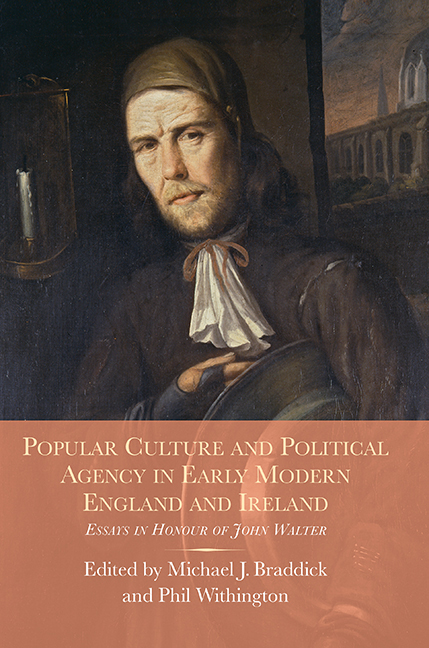 Popular Culture and Political Agency in Early Modern England and Ireland
Popular Culture and Political Agency in Early Modern England and Ireland Book contents
- Frontmatter
- Contents
- List of Illustrations
- List of Contributors
- Acknowledgements
- List of Abbreviations
- Introduction
- 1 John Walter and the social history of early modern England
- 2 Contrasting susceptibility to famine in early fourteenth- and late sixteenth-century England: the significance of late medieval rural social structural and village governmental changes
- 3 The politics of English political economy in the 1620s
- 4 Provision, household management and the moral authority of wives and mothers in early modern England
- 5 Popular senses of past time: dating events in the North Country, 1615–1631
- 6 Spectral lordship, popular memory and the boggart of Towneley Hall
- 7 Self-image and public image in the career of a Jacobean magistrate: Sir John Newdigate in the Court of Star Chamber
- 8 Gender, agency and religious change in early Stuart England
- 9 ‘A Standard which can never fail us’: the Golden Rule and the construction of a public transcript in early modern England
- 10 Religion, anti-popery and corruption
- 11 An ‘Aristotelian moment’: democracy in early modern England
- 12 John Lilburne and political agency in revolutionary England
- 13 An Irish Protestation? Oaths and the Confederation of Kilkenny
- 14 ‘Whereat his wife tooke great greef & died’: dying of sorrow and killing in anger in seventeenth-century Ireland
- Bibliography for John Walter
- Index
- Tabula Gratulatoria
- Miscellaneous Endmatter
2 - Contrasting susceptibility to famine in early fourteenth- and late sixteenth-century England: the significance of late medieval rural social structural and village governmental changes
Published online by Cambridge University Press: 09 May 2017
- Frontmatter
- Contents
- List of Illustrations
- List of Contributors
- Acknowledgements
- List of Abbreviations
- Introduction
- 1 John Walter and the social history of early modern England
- 2 Contrasting susceptibility to famine in early fourteenth- and late sixteenth-century England: the significance of late medieval rural social structural and village governmental changes
- 3 The politics of English political economy in the 1620s
- 4 Provision, household management and the moral authority of wives and mothers in early modern England
- 5 Popular senses of past time: dating events in the North Country, 1615–1631
- 6 Spectral lordship, popular memory and the boggart of Towneley Hall
- 7 Self-image and public image in the career of a Jacobean magistrate: Sir John Newdigate in the Court of Star Chamber
- 8 Gender, agency and religious change in early Stuart England
- 9 ‘A Standard which can never fail us’: the Golden Rule and the construction of a public transcript in early modern England
- 10 Religion, anti-popery and corruption
- 11 An ‘Aristotelian moment’: democracy in early modern England
- 12 John Lilburne and political agency in revolutionary England
- 13 An Irish Protestation? Oaths and the Confederation of Kilkenny
- 14 ‘Whereat his wife tooke great greef & died’: dying of sorrow and killing in anger in seventeenth-century Ireland
- Bibliography for John Walter
- Index
- Tabula Gratulatoria
- Miscellaneous Endmatter
Summary
The incidence of harvest failure in the seven centuries from the Norman Conquest to the Restoration was particularly heightened in the periods from c.1280 to c.1322 and c.1580 to c.1640. Both were phases when English population levels peaked close to, or were in excess of 5 million. However, a significant contrast can be detected between the two eras when the intensity of crises emanating from harvest failure is measured. Although historians of early modern England have undoubtedly devoted more energy to their analysis of the admittedly more copious evidence relating in particular to crises de subsistence in the Tudor and early Stuart period, indubitably inspired by the examples set by students of the Annales school, research on the late thirteenth and early fourteenth centuries seems clearly to show that this earlier period was the more famine prone of the two. While climatic conditions giving rise to cool wet summers may have been more adverse in their impact in the early fourteenth than the late sixteenth century, it is hard to attribute the differing mortality levels in populations of similar size solely to contrasting degrees of weather extreme: in 1315–17 close to 400,000–500,000 died and 1595–7 when 40,000 died in populations of similar size. Furthermore, in the earlier period there was more likely a lower proportion of landless which a priori would mean that fewer persons were dependent on the market. We might assume that significantly more people were exposed to the vagaries of dietary deficiency in late Tudor and Stuart England since dependence of wage-paid workers on the purchase of grain or bread in the market was more widespread.
The greater vulnerability of society to dearth-driven mortality surges in the period c.1280–c.1325 had been noted previously with a stress on the greater intensity of the crises and their broader geographical extent.3 Recent work on the environmental conditions, especially those which gave rise to what has come to be known as the Great European Famine of 1315–22, has resulted in the assembly of data from cores in the Greenland ice sheet correlated with temperature conditions in the North Atlantic and linked especially to dendrochronological evidence of retarded growth of Old and New World trees.
- Type
- Chapter
- Information
- Popular Culture and Political Agency in Early Modern England and IrelandEssays in Honour of John Walter, pp. 35 - 54Publisher: Boydell & BrewerPrint publication year: 2017
